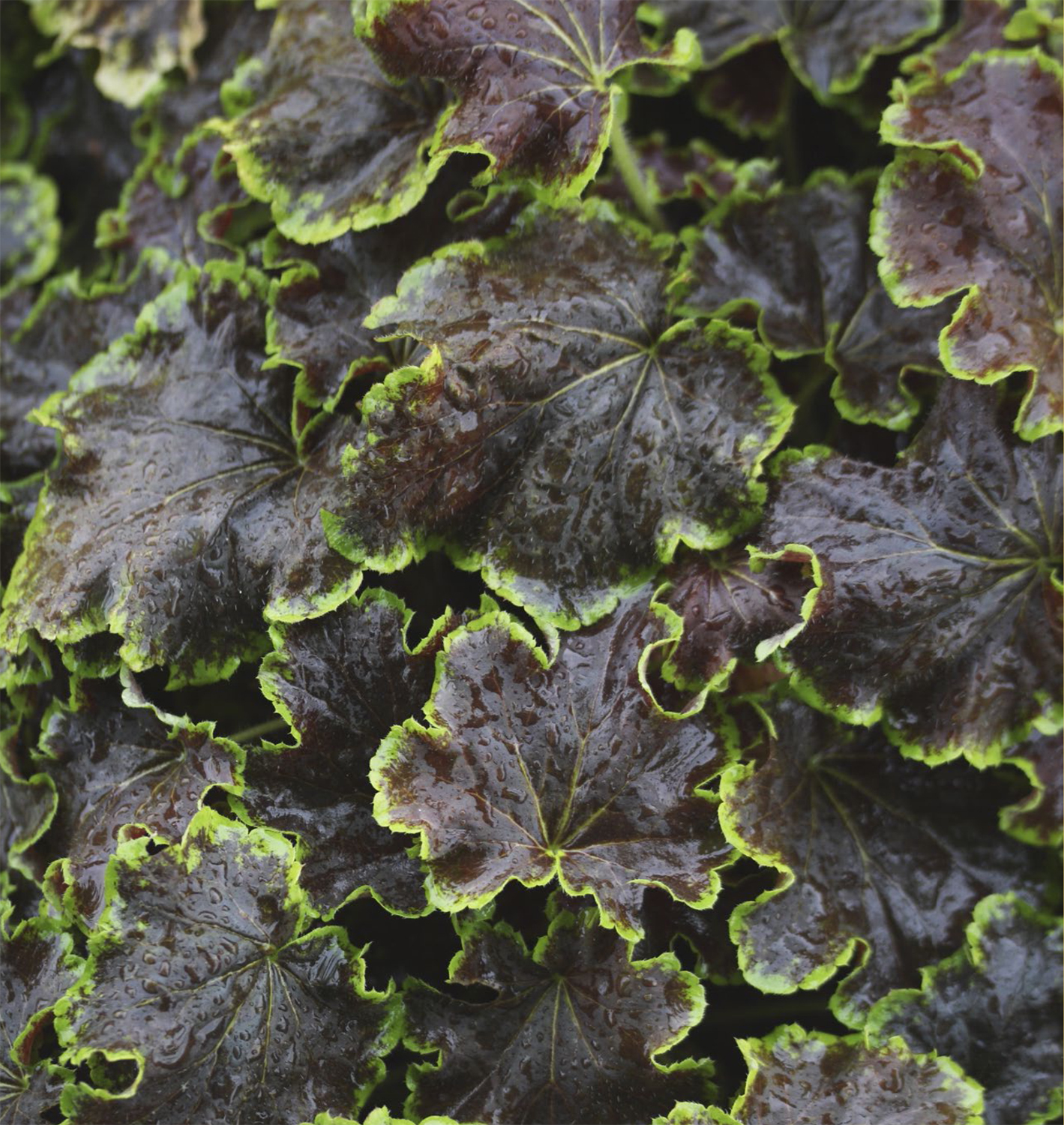
ENVIRONMENT
PLANTING AT THE INTERSECTION OF PLACE AND ECOLOGY
Until recently the standard approach to the home landscape included a large expanse of grass lawn, disciplined beds of annuals, and brutally pruned shrubs. In most cases, the wisdom of such a landscape went unquestioned, even though homeowners were actually battling nature instead of working with it.
—Ken Druse, The Natural Garden (1989)
Gardening in harmony with the environment is the new vernacular. Recognizing that gardens aren’t isolated from the world around them and leveraging that to your advantage is sure to result in a more satisfactory gardening experience—plain and simple. Giving a damn about our environment, about how it looks and how it grows, is the conscientious thing to do, a spirit that should be planted deeply into the beds and borders that extend our homes. Stylish gardening is about connecting with the earth. The best gardens are created when we embrace sense of place and celebrate ecology.
The first element of making beautiful gardens, then, is not so much the stylistic persona you’ll employ in its later development but the context in which it exists—its foundation, in other words, to settle on just one of the many apropos analogies. I sometimes think of gardens as houses, built so many stories high (or not), with walls and floors to spec, rooms or nooks at every turn. Like a house, a garden is to be decorated and lived in. Gardeners, by extension, are artists at work—dreaming, scheming, crafting, and planting their way to some kind of ever-evolving, playful finale, which, unlike the house itself, is never really all that final.
In the beginning, making a garden is about the plants that form the foundation of what you’re about to build—the plants that connect a garden to your environment, whatever it may be.
In a garden that borders parkland in Savannah, Georgia, borrowing the nearby live oak laden with Spanish moss (Tillandsia usneoides) might translate into finding a tree to dress with this common bromeliad, the obvious promulgation of sense of place.
In the Desert Southwest, regionally centric planting invokes the shape and colors of fishhook barrel cactus (Ferocactus wislizeni), repeating spiny themes abundant in the desert backdrop.
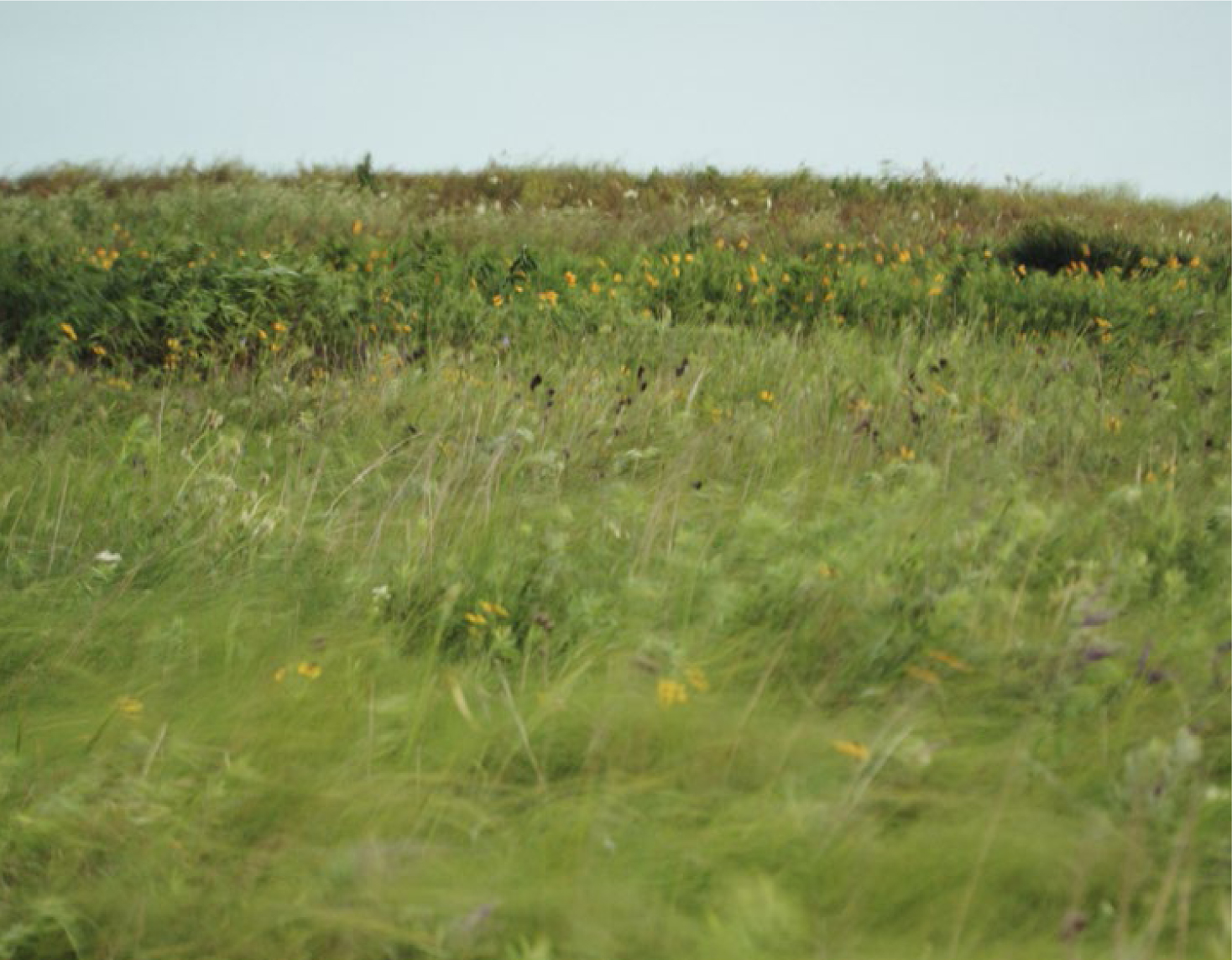
On the prairies, wind-blown grasses carry on phantom waves the mantra of modern ecology with each midsummer gust. These matrices of deep-rooted perennials teach us to think about communities of plants, thriving together in a delicate but plantable balance.
In urban environments, look to what colonizes buildings, bridges, and overpasses. Plants like Boston ivy (Parthenocissus tricuspidata) or English ivy (Hedera helix) have no place in smaller, intimate landscapes, where their brutish personalities might overwhelm everything. But forced to scale the monuments of modern civilization, they work hard to soften lines and edges.
Planting with What Grows Around You
Finding inspiration in the context of where you garden is critical, because it’s what personalizes the garden. Plants may drive the design, but sense of place gives a garden its soul. Gardens in hardscrabble neighborhoods are grounded by incorporating rough-hewn features, repurposing found objects, and letting plants fill the voids between the hardness of humanity. Those built atop a breezy hillside have see-through plants that frame views and tolerate wind. A wet spot in the backyard or the burning hellstrip next to the street prompts, at either extreme, garden making of an entirely pragmatic though no less stylish kind. The inspiration for building a new garden can quite often come from something much bigger than the property itself. Hilltop or not, it’s called borrowing the view, taking note of what extends beyond the garden’s edge and putting it to work. Sometimes it’s about repeating what’s germane to the rest of the landscape; at other times it’s about juxtaposing it. Partnering with nature, whether original or contrived, is essential for creating a sustainable space.
Certain plants dutifully evoke a sense of place, some greater feeling about the landscape that littler pieces can’t quite express. They consort with their surroundings as a result of evolution and environmental adaptation. In the context of their space, they are the right plants for that place. It follows that in every climate, some plants’ personalities (and so often their nativity) beg to be amplified.
While place may define your environment, your sense of style colors within the lines. And while your environment may well define your palette, it never has to limit it. Gardens should be outgrowths of their surroundings, even if as expressions of their creators they seek to convey something unfamiliar. You won’t be the first to create an Asian garden in the middle of the desert, for example. In hot, exposed, waterwise gardens, the fiercest colors deserve serene coordinates. The wailing red flowers of Texas firecracker bush (Anisacanthus quadrifidus) or California fuchsia (Zauschneria californica) cry for cool companions: try Mexican blue sage (Salvia chamaedryoides) or Santa Barbara sage (S. leucantha ‘Santa Barbara’). Add the blades of Agave desmettiana ‘Joe Hoak’ or A. havardiana to at once unify the vignette and tie it to the greater landscape, with pointed rosettes of accenting and contrasting colors.
Almost every garden I’ve ever explored in the Pacific Northwest causes me to consider scale. There, the boreal native landscape celebrates evergreens like western red cedar (Thuja plicata) and Douglas fir (Pseudotsuga menziesii). Often shrouded in foggy cloaks, the permanent, static scaffolding of these trees frames the landscape in distinctly regional terms, while the cultivated landscape revels in Asian natives that are at home in the Left Coast’s similarly maritime climate. Notable and obvious among these are the Japanese maples (Acer palmatum).

Mexican blue sage (Salvia chamaedryoides).

Agave havardiana.
A slough of ferns (including Adiantum and Polystichum) and Spanish bluebells (Hyacinthoides hispanica) looks authentically Left Coast, reveling in seasonally abundant moisture as observed here at Hatley Park, Royal Roads University, Victoria, B.C.
Underneath the Pacific Northwest’s well-architected canopies flourishes a palette of plants adapted to shade, acidic soils, soggy springs, and rainy autumns with a three-month dry spell in between. Ferns like Adiantum aleuticum and perennials like Trollius laxus symbolize the natural “gardens” that populate the wild slopes of the region’s mountains and forests. But in a climate so generous and paradisial (did I mention mild winters?), it is tempting to garden with plants from anywhere. The Chinese native Beesia deltophylla, the rare and unusual groundcovering relative of buttercups, is one such example, forming glossy carpets that rival freshly varnished floors for sheen and shine. Tough, sturdy foliage seems to soak up the downpours of spring just enough to last through the lingering dryness of summer. Outside the Northwest, it grows with mixed success. It wilted into a disheveled salad in my loamy Iowa garden a few summers ago, but I’ve admired fine masses of it in Michigan in the same months. In flower it’s airy and elegant, with foamy white stars that alight on delicate, ascendant stems.
On a plant hunting trip to the Black Hills one July, I found myself at sundown immersed in a shortgrass meadow that embodies perfection in my memory unlike few other vistas I can recall. Silver, shield-sized leaves of the deeply taprooted balsamroot (Balsamorhiza sagittata) and ascendant spears of white sage (Artemisia ludoviciana) knit themselves together in a tight weave, growing in communal competition. Two plants made this vignette magical, a simplistic matchup of dynamic foliar personalities and a reminder that less is so often more. In an area of the country so sparsely populated, taking in this view seemed like a rare privilege. In the same meadow on the other side of the hill, the pattern repeated itself, only with additional elements. Absent the dramatic leaves of the balsamroot, the texture was finer, instead drawing on the subtler contrasts in color between the silver leaves of the artemisia and the bubblegum and blue flowers of Astragalus laxmannii, a legume known only to rock gardeners unfortunately, all arrayed amid a bladed carpet of sedges, sand lovegrass (Eragrostis trichodes), and prairie junegrass (Koeleria macrantha).
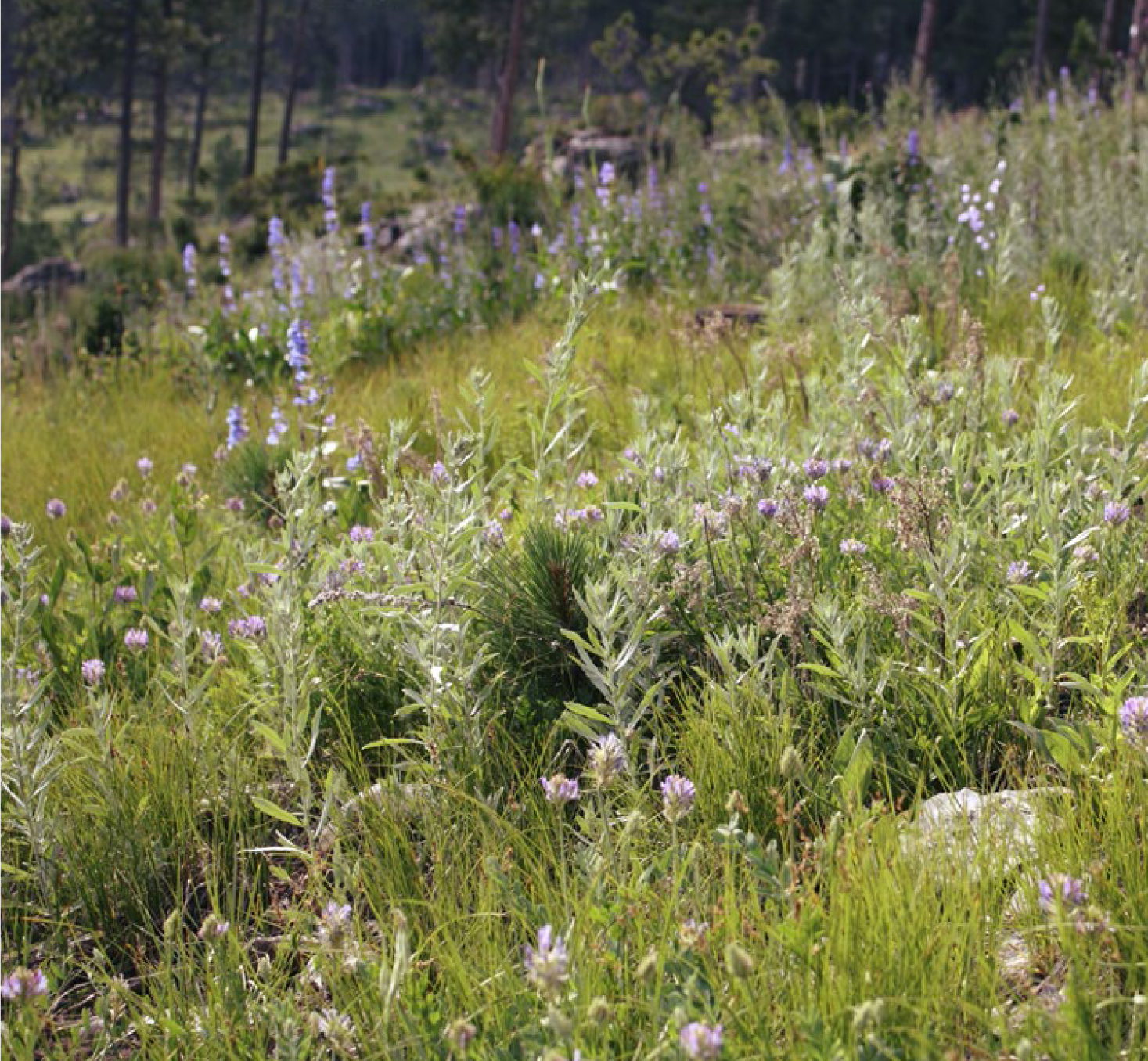
If you’ve never dreamed of a meadow front yard, start now. Imagine the possibilities.
A prairie dominated by indiangrass (Sorghastrum nutans) near my hometown in southwest Iowa stands as a reminder of the frontiers of biodiversity that remain unexplored by most gardeners. They thrive by the thousands, locked in an ecological dance with goldenrods (Solidago) and big bluestem (Andropogon gerardii).
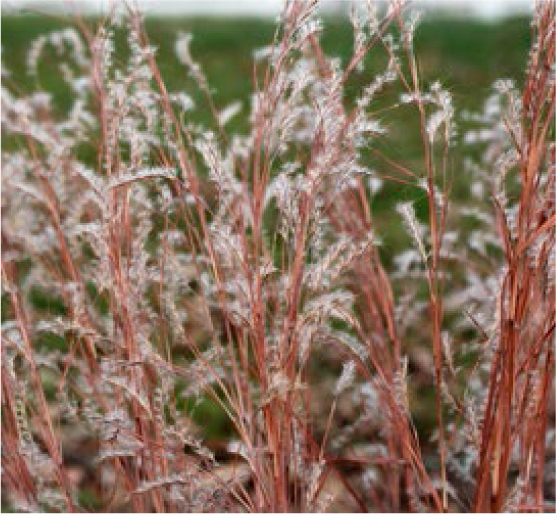
Little bluestem (Schizachyrium scoparium).
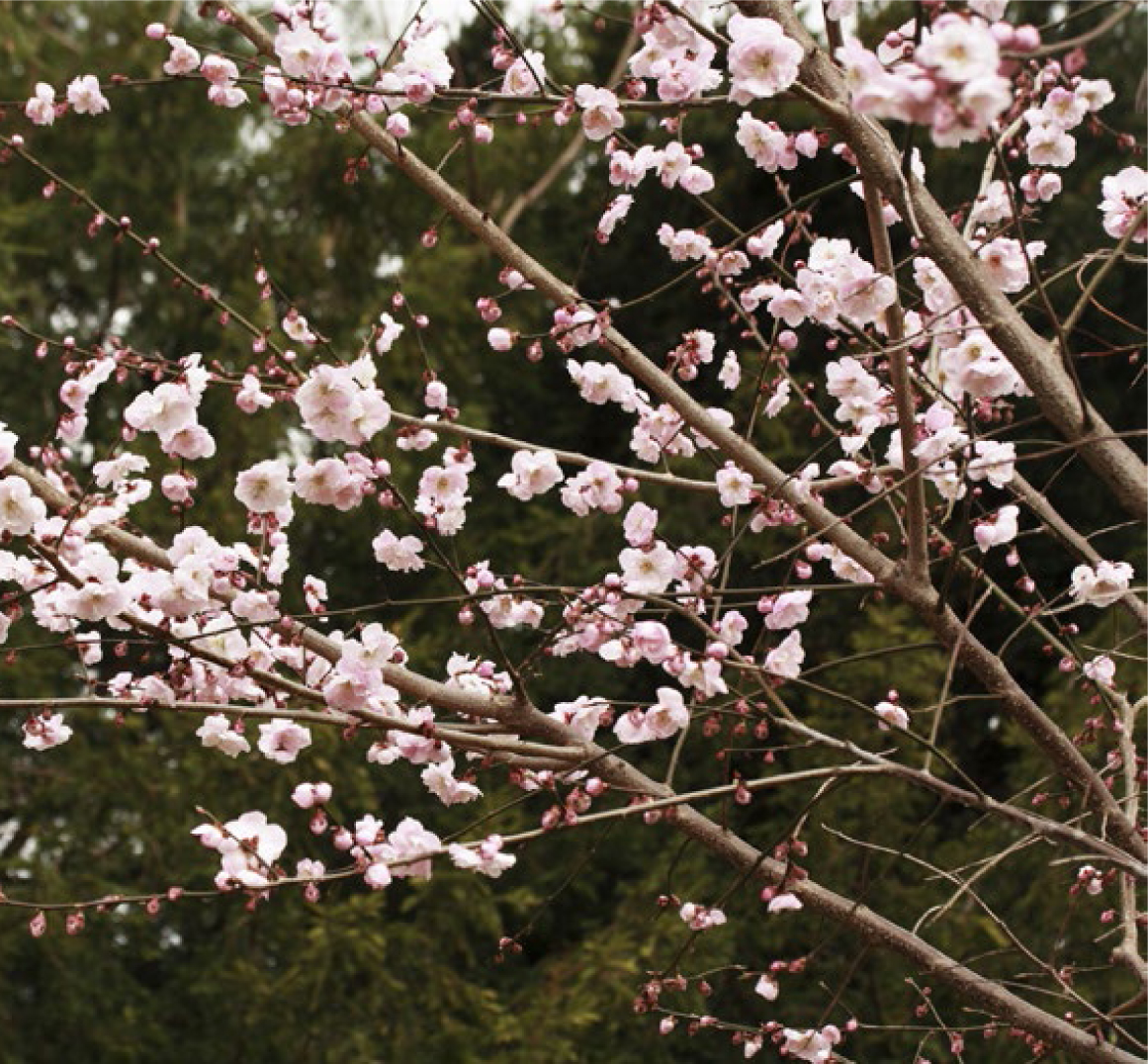
Japanese apricot (Prunus mume).
In the Midwest, grasses like indiangrass (Sorghastrum nutans) and little bluestem (Schizachyrium scoparium) bring motion to the garden, catching the spirit of the prairie from the winds that rustle through their culms. Growing up and traipsing through the remnants of formerly expansive prairies, I relished these grasses as they tickled my legs and arms. Both indiangrass and big bluestem (Andropogon gerardii), the taller cousin of little bluestem, are remarkably absent from North American gardens, even though at one point in biogeographic history they were nearly the most populous plants on the continent. New cultivars of indiangrass from Iowa State University offer a glimmer of hope for the species as it slowly earns some street cred as a garden staple. ‘Bantam’, a dwarf, and ‘Redspike’, an aptly named variety with red-tinted spikes, join ‘Indian Steel’ and ‘Sioux Blue’ as some of the only representatives of this species on the marketplace. The latter two, besides evoking nonexistent rock bands in name, really earn points for their pewter and aquamarine leaf blades, respectively.
Venture to the Deep South and you’ll undoubtedly encounter southern magnolias (Magnolia grandiflora) and Japanese apricots (Prunus mume). The southern magnolia is instantly “known” to us, familiar from historic paintings, novels, and movies that depict the story of the American South. With hefty, glossy leaves and a broad canopy, a singular Southern magnolia speaks southern in a dialect that few plants can. Japanese apricots, the favored geishas of the southern winter garden, are thirty years into their life in American horticulture, elevated from obscurity by famed plantsman J. C. Raulston in the 1980s. In the eyes of plantsmen, it’s the belle of cold months, coveted for its pink and white rosettes that dangle charmingly in a lonely season, when little else matters. I’m giddy at the mention of it, recalling the first time I encountered the plant in Tennessee in mid-February—the perfect grace note for a winter blues day. While the flower colors are relatively limited—white and red forms mark the ends of the spectrum, with most coming in near pink—the international sentiment they express is more than enough to make up for it. Hovering over the doorstep, framing the entrance to the house, a Japanese apricot now couldn’t look more quintessentially southern.
In the Northeast and Great Lakes, I love encountering sugar maples and the various fiddlehead ferns (Osmunda cinnamomea, Matteuccia struthiopteris) in well-mannered abundance, icons of the eastern North American forest. This native landscape is an ecotone that expands over millions of acres and a dozen states. As home to our country’s earliest settlers, this portion of the continent arguably shows the greatest impact of humanity on the native landscape. At the margins of development, natives and nonnatives mingle precariously in ecological imbalance. Yet further into the wild, beyond the greater metropolises of the coast, tall groves of hardwoods still shade lush carpets of ferns, ephemeral wildflowers, and shrubs that were the beginning of America’s horticultural heritage.
Spicebush (Lindera benzoin), an eastern native to be prized, earns few raves nowadays, despite its near essential role in delivering the earliest doses of color in spring. Tiny yellow flowers dot the gray stems of this large upright shrub that Thomas Jefferson valued for its potential use as a flavoring. In fall, the plant reprises its role in the garden as an effusive source of beaming yellow.
Sweet fern (Comptonia peregrina) and Rhode Island have a lot in common, primarily that neither of them is what their name describes. A singular relic of a genus long extinct, this stemmy shrub grows three to four feet tall often in the companionship of pines on sandy soils, though it adapts to a range of loamier soils, particularly in garden settings. Texture is the operative word, as its common name suggests—ferny, frond-like leaves extend in waves from leathery stems that age to bronze in the waning days of autumn.
The fact is that within any one region, there are dozens of plants that characteristically define the garden. Regardless of style, incorporating at least some of these in the garden’s palette bodes well for some semblance of ecological authenticity. The native plant movement has long called on a gardener’s civic duty by appealing to environmental responsibility. That message has given way to a lasting, sustainable paradigm of American horticulture. When we plant natives, we embrace our environment. Embracing what we have, for its opportunities and challenges, means at the core we are taking inspiration from the environment at large and accepting responsibility for it. That’s not to say just because you support local farmers that you can’t have a good Bordeaux on occasion. Similarly, just because you embrace your local plant palette, doesn’t mean you can’t celebrate wild gems collected from around the world. The lines of ecology and evolution aren’t as easily drawn as the boundaries of continents or geopolitics. As a design idea, it makes sense to embrace sense of place. As a model for ecological goodness—the harmony of living in context—it’s more than sensical; it’s golden.

Sweet fern (Comptonia peregrina).
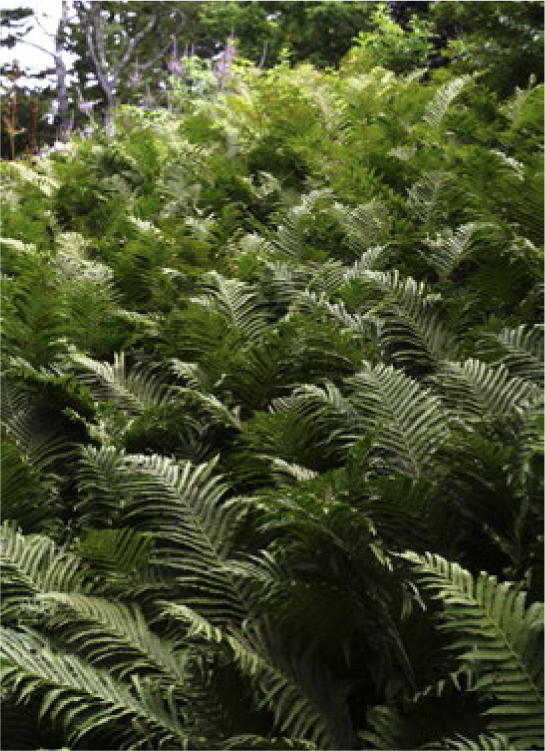
An expansive colony of ostrich fern (Matteuccia struthiopteris) at Coastal Maine Botanical Gardens, Boothbay, Maine.
The André Bluemel Meadow at the American Horticultural Society’s River Farm represents the ultimate alternative to the traditional American lawn with four acres of woven grasses and forbs nestled along the Potomac River.
Making The Garden with What You Have
With a solid ethos rooted in embracing our environment, we can more confidently approach the challenges of making gardens while simultaneously reveling in the rewards. Celebrating plants, after all, gives gardening its thrill; the merrymaking is in the details—but that comes later. Connecting a garden to environment starts not only by considering how the space is to function but by frankly acknowledging soil, light, and the domination of climate and its range of temperatures. To prioritize the discussion, I’ve charged off hardiness and functionality to peripheral conversations. The functionality of any garden space is a subjective choice, one the gardener must make when charting a new horticultural adventure. Hardiness is all encompassing—plants either are hardy in your garden or they are not. Thus, the two biggest considerations when starting a new garden, renovating an old one, or retouching an existing one are soil and light. Remember, no matter your circumstances, there are almost 250,000 known species of flowering plants: there is a plant that will thrive, whatever challenges a garden presents.
YOUR SOIL ISN’T AS BAD AS YOU THINK
No matter what you call it—soil, dirt, mud—the rawest of the elements you’ll face when making a garden is the stuff underfoot. Gardening on less than desirable soil seems to be the norm—at least you’d gather as much over weekly coffee with your gardening friends. In short, everyone thinks their soil sucks. Mention clay to a fellow gardener and you’ll likely get a grimace in return. While some gardeners in the western United States might bemoan their sand and constant aridity, surely the fiercest enemy in the fight for good gardens everywhere is clay soils, those that have a higher ratio of clay to silt, sand, or organic matter. Gardening in clay soils isn’t exactly the kind of bliss most gardeners look forward to as they leave the house, tools in hand on a summer morning. Too often, gardeners struggle with clay, feeling the urge to do battle against the soil instead of accepting the nature of the dirty world below their feet; but as they quickly learn, clay soils tend to become elastic, spongy, and slimy with the addition of water and, in drier periods, firm, rigid, and sometimes powdery to the touch.
Regardless of how bad you think your soil is, gardening on it isn’t impossible, even if at first it seems more like battle and war than love and peace. To borrow a saying—garden smarter, not harder. Let’s raise a trowel to working with the soil you have. There’s a cast of plants ably suited to the challenge.
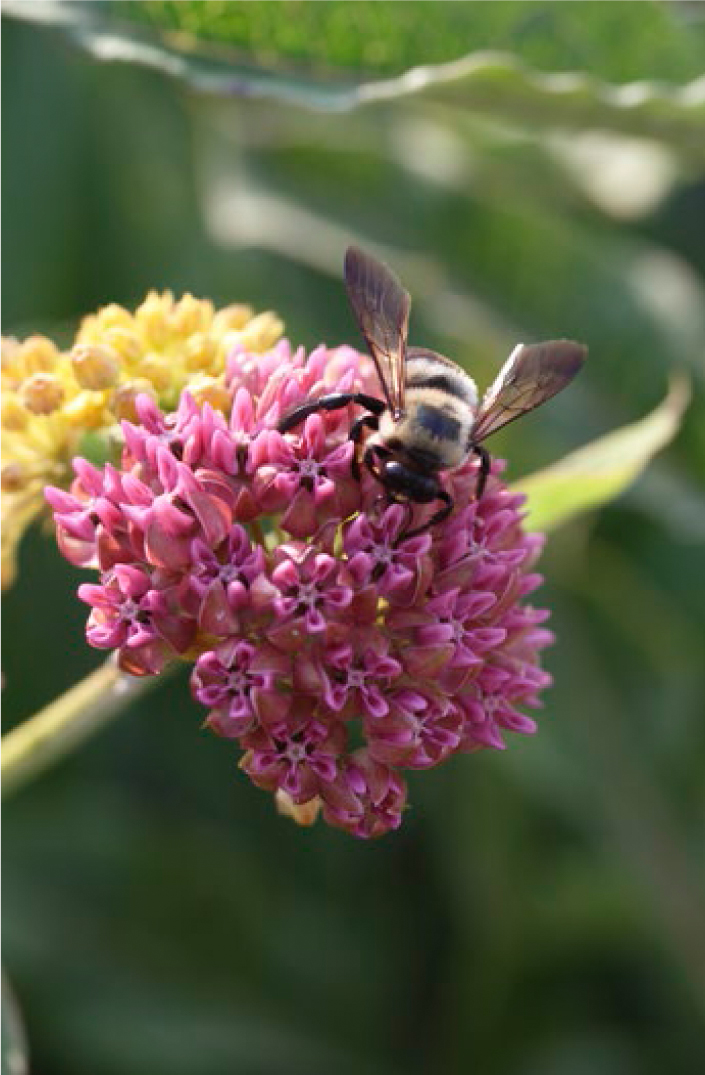
Purple milkweed (Asclepias purpurascens).

Redring milkweed (Asclepias variegata).
Unfortunately the reputation of milkweeds stretches unfairly between two poles—on one end sits the smashingly orange but sort of commonplace butterfly milkweed (Asclepias tuberosa) and on the other the weedy and dastardly common milkweed (A. syriaca). Don’t get me wrong, I secretly like them both (the former far more than the latter) for their intense durability under a variety of conditions. Even if the usual butterfly milkweed packs an ordinary punch, the color variants are where the KO is. Various shades of red and yellow grow on the benches of nurseries, often propagated from local populations and sold under various names. The reds have a rusty quality to them; the yellows verge on golden. My favorite is a dwarf yellow form (sold under that description) I picked up at The Flower Factory near Madison, Wisconsin. It flowers profusely on stems half as tall as the usual variety.
Lovely as they are, this sampling of the milkweed tribe is remarkably shallow. With a genus numbering some 140 species (over seventy of which are native to North America), the possibilities for finding the right plant for the right place are far greater than what available offerings would suggest. At the top of my list, at least in terms of their garden worthiness, are two co-reigning champs. Though not a plant for the stickiest of clay, purple milkweed (Asclepias purpurascens) grows across a remarkable range in the wild, inhabiting dry, rocky glades and moist, shaded, lowland savannas, where it often grows contentedly in some clay. In the Ozarks, it’s an effortless addition to the understory. In the garden, it’s a plant that requires some patience, like all comely milkweeds. But while you’re being patient those first few years or so, the roots of your purple milkweed mine themselves deep into the ground, establishing a dense taproot with a network of woody roots—all words you want to read in the description of a clay-busting plant. When finally established, the rewards—vibrant, rouge-colored flowers—are worth the wait. Equally slow but just as valuable is the redring milkweed (A. variegata), a native of the eastern United States that bears delicate clusters of pearl flowers with a distinctive red halo. Rarely encountered, its presence in a garden means two things—someone has impeccable taste in milkweeds and a security system armed to ward off would-be looters. In short, a plant worth cosseting, once you lay hands on a division.
BLUESTARS
Bluestars (Amsonia) are close kin of milkweeds, recently classified as belonging to the same family (Apocynaceae). For those less concerned with taxonomy, the lessons of the family are worth repeating—bluestars, like milkweeds, have a predilection for growing in tough soils, from clay to sand. In the wild, these sixteen or so North American natives grow from the Desert Southwest in loose scree to the East Coast in woodsy humus. In the garden, they are bellwethers of spring’s climax. Four earn appraisals here. The first, A. tabernaemontana ‘Short Stack’, is a dwarf form of the common eastern bluestar, a distinctive specimen with little penchant for reseeding. As much as I love the bluestars, they can be a weedy bunch, shooting umpteen little bluestars into the garden universe, often where you least want them (the only wish you’ll make on these stars is that they shed a thousand instead of ten thousand seeds). Tony Avent’s ‘Short Stack’ short circuits those genetics, at least in my experience, politely filling out its border home with nothing but charm and grace. A little taller is A. illustris, an inland relative of A. tabernaemontana found in the south-central Plains and the Ozarks. With glossier, narrower foliage and pendent seed pods, its ornamental effect is subtle by comparison but still desirable.
In stark comparison to those already mentioned, the ciliate bluestars (Amsonia hubrichtii and A. ciliata) sport filigree foliage that turns enviable shades of gold and yellow in autumn. If you haven’t heard, there’s nothing unexpected about the color of bluestar flowers—they are blue, on a scale of silvery to periwinkle and only rarely white. Their value lies in their flowering time and plant habit. If you’re looking for an unusual form of these fringy bluestars, seek out A. ciliata ‘Georgia Pancake’, flat from the frying pan of this meritorious plant. “Had I the heavens’ embroidered cloths,” they’d hardly compare to the golden rug of this plant in fall color. Did I mention that all these are deer resistant? Their virtues are endless.
NOTHING FALSE ABOUT FALSE INDIGOS
Growing up, I poked around prairie remnants in southern Iowa, seeking out plants that fascinated me with their beauty in otherwise bygone places. Welcoming them to my garden didn’t seem novel or part of a movement—it was an answer to a child’s fascination with flowers so close to home and yet so precious and rare. Among these plants, which I admittedly failed to cultivate with success until I was older, were two false indigos—Baptisia alba and B. bracteata. The former is the prairie’s version of a string of pearls, dangling along the upper lengths of four- to seven-foot-tall stems. Sculptural to an artist’s eye, it’s rare in gardens, probably because it doesn’t fit the paradigm of modern nursery production. Native plant nurseries occasionally offer it, though establishing it is a lesson in patience with a dose of memory loss and apparent neglect. To grow its umbrella of pressed, pea-like foliage and watch its flower buds spurt into these lithe and lilting stems is a precious blessing. Similarly, cream wild indigo (B. bracteata) remains one of the coolest plants on the planet, if I was inebriated enough to chart the list. It grows and flowers much closer to the ground than its tall, white cousin, a softer-shaded blossom skimmed from the finest milk. Tony Avent named a selection with generous clusters of ground-hugging flowers ‘Butterball’. If I counted the number of times I’d failed at growing this plant, I’d run out of fingers. When I finally succeeded—the pitiful excuse for soil that it made roots in notwithstanding—all trials were forgotten.
Any one of the numerous new hybrids of false indigo makes a striking focal point in the spring garden. A three- or four-year-old established clump is enough to stop traffic, a natural response (sheer disbelief) to its busty presence in the perennial border. With showy hybrids like Baptisia ×variicolor ‘Twilite’ (Twilite Prairieblues) and B. ‘Solar Flare’ (Solar Flare Prairieblues), you can’t help but want to dot a few of these in the roughest soil you have in an act of warfare-like defiance. False indigos have notoriously deep and fleshy root systems, ably suiting them to the stickiest of clay soils but also making them fairly recalcitrant to division at any time of the year except early spring. Small machinery, teams of sherpas, and archaeological permits may be necessary should you desire to relocate a toddler-aged specimen. The bottom line: site carefully and permanently. In turn, false indigos will reward the garden scene with hundreds of pea-shaped flowers spring after spring for much longer than you can imagine, much less intend. Who doesn’t love a tough plant with values like commitment? Other new varieties worth naming include the Decadence series from Proven Winners, with diet-crashing names like ‘Lemon Meringue’, ‘Cherries Jubilee’, and ‘Dutch Chocolate’. In short, most new varieties, regardless of their origin, reward similarly—bountiful floral displays, stocky architecture, and prairie-style star power.
A seed-grown selection of Oenothera macrocarpa ssp. fremontii growing in my scree garden with flowers aplenty.
THE DAWN OF EVENING PRIMROSES
You’ll surely pick up on a theme in this book before long—I feel a duty to champion genera that are either underrated or disregarded entirely. While I don’t suggest the latter is true of Oenothera, it’s certainly true that this amazing genus of so-called evening primroses, suncups, and sundrops hasn’t gotten its due in the American garden. As if those common names weren’t suggestive enough, the overwhelming majority of species and cultivars tend toward yellow and nearby hues. Oenothera tetragona, with its sun-soaked, bowl-shaped flowers, epitomizes the effect, and several of its cultivars have merit, perhaps because they thrive in everything from good, compost-heavy garden soil to the thin remnants of topsoil left in the hellstrip. ‘Fireworks’ is one of the best, with red buds giving way to a sunrise surprise (I’m always apt to give a plant points for a well-placed surprise). It’s a consistent performer, never lacking for flowers even through the hottest days of summer. If you’re with me in the surprise camp, you have to grow O. versicolor ‘Sunset Boulevard’ for its arresting crimson, amber, auburn, and maroon-blended flowers that make even the best tequila sunrise look like Kool-Aid. Backlight it and you’ll faint.
If drunken celestial colors aren’t your thing, you might consider Oenothera macrocarpa ssp. fremontii, which has the added benefit of scintillatingly silver foliage. Native to chalky, rocky soils (read: hell) in northern Kansas and south-central Nebraska, these silver salvers serve up yellow flowers, sunny and tastefully lemony, on the eve of high summer—an eloquent way of saying that these flowers show up when it’s blisteringly hot out. Several nice forms and selections of this showy Great Plains native are available, with image-conjuring names like ‘Shimmer’, ‘Silver Wings’, and ‘Comanche Campfire’. Of these, ‘Shimmer’ has the highest “hot or not” score for its dazzling foliar presentation and floriferousness.
Cercis canadensis ‘Forest Pansy’ seen from below, a scintillating reminder of the power of backlighting.
SHADY BUT NOT SKETCHY
Light is equal to soil in terms of its primacy in the garden and yet is the most under-realized character as a source of inspiration there. Consider this—light plays an enormous role in framing the views of plants in combination. Backlit, some take on a completely different personality; gleaming and glinting surreally, they look nothing like their appearance at high noon.
Then of course comes the practical application of light. Some plants need to grow in full sun, others in full shade. Some have evolved to make do in the middle, preferring a Goldilocks-blend of light and darkness throughout the diurnal cycle. In urban gardens, shade predominates due to the psychological yearning city dwellers and policymakers have for canopy, green space, and respite from the rigors of metropolitan life. In suburban and country gardens, wider vistas open up. By itself, the exposure of a garden poses few limitations to the plant palette, contrary to the long-held notion that shade gardens are the scourge of horticultural ambition. In fact, shade gardens don’t have to become hosta ghettos underneath tall, old trees. Shady exposures offer as many possibilities for assembling a dynamic garden as sunny exposures, even if the characters that populate the scene prefer the darker corners of the garden.
A mosaic of silver and speckled leaves, heucheras and tiarellas carpet the ground of the trial garden at Terra Nova Nurseries, Canby, Oregon.
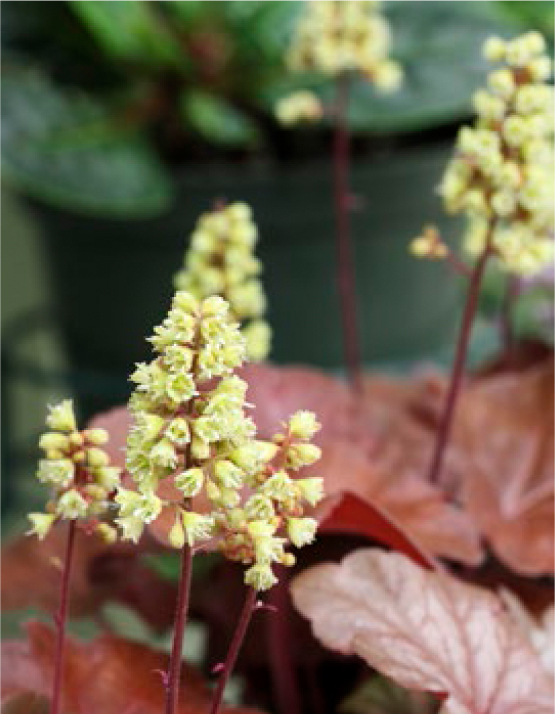
‘Blondie’ from Terra Nova’s Little Cutie series is a smashing variety for the patio or windowsill, a houseplant heuchera that looks like something Penny Singleton might have cooked up if ever there was one.
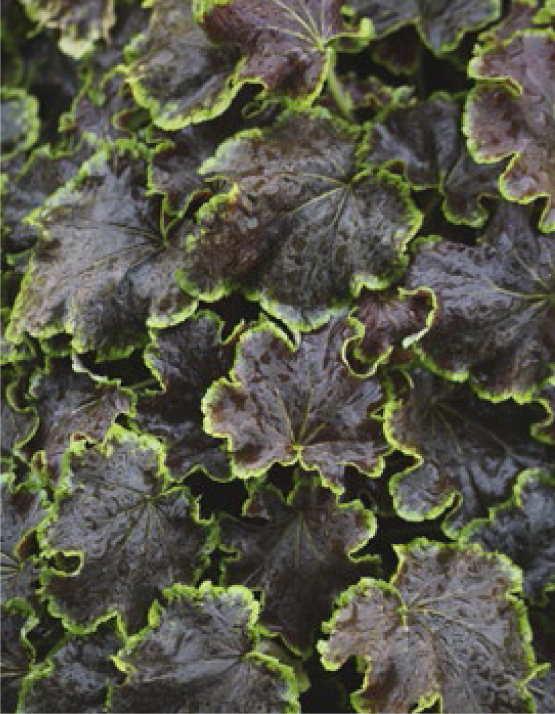
×Heucherella ‘Solar Eclipse’.
HEUCHERAS, HEUCHERELLAS, AND TIARELLAS
It’s worth stating the obvious. What is there to say about coral bells that hasn’t been said already? They are fabulous, leafy-luscious companions for just about any other perennial that hangs out in shady places—the cheese to pair with the wine. Without question, Dan Heims of Terra Nova Nurseries is the Heuchera dude, and his introductions best the too-many-to-count and too-many-to-grow varieties on the market.
Picking a few to highlight seems almost futile, but a handful of recent introductions deserve extra fanfare. The Little Cutie series stands apart from the rest for the diminutive size of its members. Perfect for containers, small dishes, and even windowsill gardens, these tykes flower profusely against a backdrop of foliage ranging from warm and copper to shiny and silver. My favorite of the bunch is ‘Blondie’, if only for the bakeshop contrast between its flowers and leaves—like frosting on a cakey square.
Foamy bells (×Heucherella) are the horticultural love children of coral bells (Heuchera) and foamflowers (Tiarella), and a fine expression of both parents at that. Many recent introductions seem to capture the roving nature of T. cordifolia, which I find desirable; some gardeners accuse this southeastern native of being rampant, but there are worse weeds to do battle against. Of the roamers, ‘Yellowstone Falls’ and ‘Redstone Falls’ from Terra Nova earn high marks for their spilling habit in containers or carpeting quality in the ground. ‘Solar Eclipse’ couldn’t have a more descriptive name, even if my mind wanders, once again, back to the bakeshop when viewing its Hershey’s-dark lacquered leaves edged in crisp mint. It’s a clumper too, minding its crowns without wandering stolons to contend with, and when planted alongside something that converses with its mint edge, the effect is—in a word—jaw-dropping.
Finally, foamflowers. Tiarellas have unrivaled elegance when it comes to plants that form lovely carpets. I’ve been most impressed by the River series from Sinclair Adams of Dunvegan Nursery (the godfather of the heuchera-tiarella clan), which harken back to their native roots in style. ‘Susquehanna’ is my favorite, the shortest of the series and with the most heavily marked leaves. Nobody can argue with its rampant growth, which makes it a great groundcovering alternative to the boring something-or-others you’ve had to choose from. The series earns its keep in dry shade, in particular, where members seem to be right at home despite their water-inspired names.
THE UMBRELLA RULE?
A couple feet above the ground a few members of the shady characters gang occupy a uniquely low canopy. These umbrellas of sorts hover more than cover, and planting them for said effect utilizes them brilliantly. If you’re looking for a savvy move to play on your gardening friends, consider planting either mayapples (Podophyllum) or Syneilesis aconitifolia. In different seasons, in different ways, these two very different plants accomplish the same thing—they disrupt the expectation that texture in the shade garden exists completely at your feet.
The North American mayapple (Podophyllum peltatum) looks great when viewed from above and excellent when viewed from below. How a gardener accomplishes this is entirely dependent on circumstance. I’ve always imagined planting them along a wall or a hillside where the grade drops off to permit viewing from beneath. However you can magnify the leaves of this plant, do it. In woodsy soils with ample moisture, you’ll cultivate a colony of mayapples, which earn their name from the apple-esque fruits that follow delicate, white blossoms. From China, the related P. hexandrum and P. pleiandrum ratchet up the umbrella effect with considerable panache—bigger leaves, bigger clumps, and red fruits. Hubba, hubba, hey. All around, these deer-resistant plants will grow as much as your soil feeds them—more compost equates to more growth.
Particularly when accented from below by solid textures, the tattered leaves of shredded umbrella plant (Syneilesis aconitifolia) are nothing short of exquisite. A cold hardy perennial native to the Korean peninsula, this is one rhizomatous colonizer that no serious shade gardener should be without. In early spring, much like the mayapples, the whorls of palmlike, down-covered leaves pop from the ground like cocktail umbrellas at a luau. As they stretch higher, the leaves unfurl into beautifully dissected arrays. Most people pity the flowers, and while they are certainly not worth a stir, their wiry stems piercing the foliar canopy adds just another element of intrigue to a plant that already doesn’t lack for it.
FLOWERS IN SHADE
Unlike the ragtag band of criminals masquerading as musicians in the 1955 black comedy The Ladykillers, the lady’s slippers (Cypripedium) shout (quietly) class, even if they prefer the shadier corners of the garden. In spring, they reign supreme, holding forth in clumps of voluptuous flowers. Several species are worth extolling; all should clamor for your attention, but most are unfortunately quite expensive, mainly because it can take years to produce salable plants. New breeding work from Werner Frosch in Germany has produced several enticing interspecific hybrids, among them ‘Gisela’, ‘Gabriella’, and ‘Anna’. The number of individuals advancing this genus seems to be increasing—if only the world had more lady’s slippers, world peace might be within reach.
When obtainable, many of the native species settle in nicely given acidic soil and ample moisture. But make no mistake, these are not plants for the beginning gardener—for the price tag associated with the investment, it’s wiser to take a chance only when you’re sure you can give these collectables the conditions they need. Among the easier species to grow and obtain from nurseries are Cypripedium reginae, C. kentuckiense, and C. parviflorum. In woodland gardens with humus-rich soil, these pocketbook-shaped flowers borne on eighteen- to twenty-four-inch-tall stems will reward abundantly for years, the ultimate union of sexy and sustainable.
If I challenged you to make a list of plants that bloomed in electric colors in the shade from the high summer months through fall, you probably wouldn’t end up with much of a list. My leading example is hoary skullcap (Scutellaria incana), which grows in far fewer gardens than it should. First, it gets points for dry shade, owing that adaptability to its native home in the Ozarks. Second, its cobalt blue flowers arrive in July and August, just as the hostas start to give in to midsummer heat. It has a lax, though not floppy, habit and surely looks good mingling with Hydrangea or Calycanthus at the edge of the shade garden. Each little helmet-shaped flower gives way to cute, jewel box–shaped seed pods that contain one or two seeds. I’ve only experienced polite reseeding, but planted en masse, you’re guaranteed a swoon-inducing show.
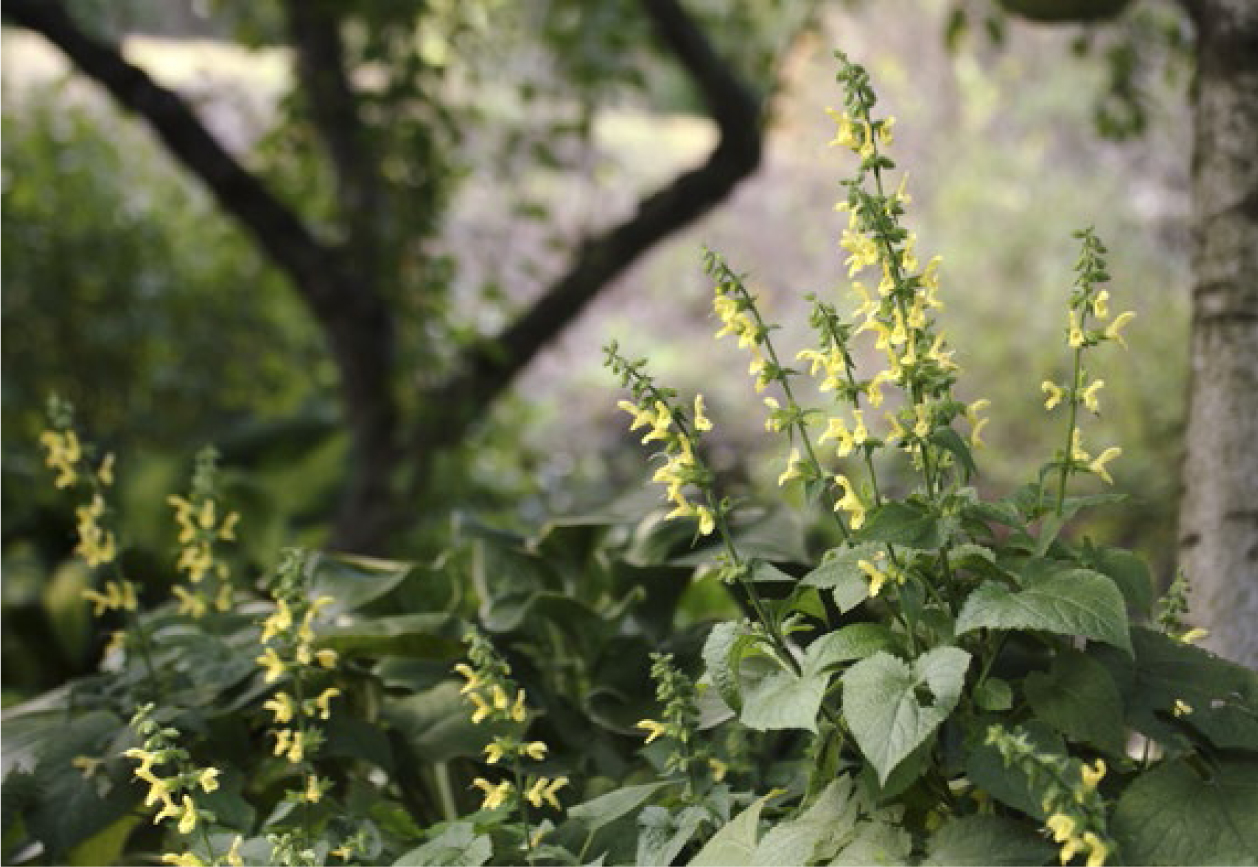
Japanese woodland sage (Salvia koyamae).
While most gardeners probably consider Salvia for the sunniest of exposures, a small band of Japanese natives prefers the cooler realms of the shade garden, cooler soils included. The first I gardened with was Japanese woodland sage (S. koyamae), a fabulous yellow, autumn-flowering herb that quickly fills out into a three-foot-wide and -tall mass of buttery awesomeness. Then I invited the hairless Japanese woodland sage (S. glabrescens) into my gardening life. Indignant at my ignorance of this species’ existence, I was flattered by the cultivars ‘Shi Ho’ and ‘Momobana’, purple and hot pink, respectively. In the garden, they behave similarly to S. koyamae, preferring woodsy soils under a mostly shaded exposure. They too are fall-flowering, indeed among the last perennials to begin flowering in zones 5 and 6.